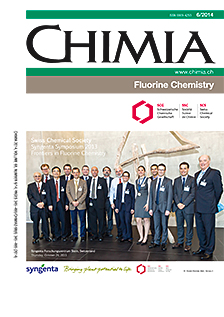Selective Incorporation of Difluoromethylene Moieties into Arenes Assisted by Transition Metals
DOI:
https://doi.org/10.2533/chimia.2014.414Keywords:
Arenes, Difluoromethylation, Difluoromethylene, Cross-coupling, Transition metalAbstract
Fluorinated compounds are of significant importance in various fields due to their unique chemical, physical, and biological properties. Accordingly, the incorporation of fluorine atom(s) or fluorine-containing functionalities into organic molecules has received considerable attention. For decades, extensive reports and reviews mainly focused on the fluorination and perfluoroalkylation (especially trifluoromethylation) whereas the preparation of partially fluorinated compounds was less developed. Difluoromethylated arenes and their derivatives (ArCF2R, R ? F, Rf, H) have been found to be as important in pharmaceuticals as trifluoromethylated arenes. However, it is only recently that these compounds have experienced a revival of interest from synthetic chemists. The direct construction of carbon(sp2)–carbon(sp3) bonds via transition metal-mediated cross-coupling reactions represents one of the most straightforward strategies for the introduction of difluoromethylene moieties (CF2R, R ? F, Rf) to aromatic compounds. This mini-review focuses on recent advances of this research topic from both synthetic and mechanistic perspectives.Downloads
Published
2014-06-26
Issue
Section
Scientific Articles
License
Copyright (c) 2014 Swiss Chemical Society

This work is licensed under a Creative Commons Attribution-NonCommercial 4.0 International License.
How to Cite
[1]
B. Gao, C. Ni, J. Hu, Chimia 2014, 68, 414, DOI: 10.2533/chimia.2014.414.







